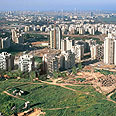
Petah Tikva
Experts: Periphery gaining strength
Exclusive data obtained by Calcalist shows 20% of apartments sold in Tel Aviv in past year belonged to city residents who left for periphery – rate that has nearly doubled in two years. Experts equate trend to young people moving from Manhattan to Queens due to high costs
"Tel Avivians are fleeing Tel Aviv," says a marketing manager at a company constructing residential buildings in Petah Tikva, Netanya and Rishon Letzion. This feeling, prevalent among real estate agents in Tel Aviv's satellite cities, is now supported by precise data obtained by Calcalist.
A survey conducted by the Real Estate Appraisers Association found that 20% of the apartments sold in Tel Aviv in the last year belonged to Tel Aviv residents who chose to move to another city; two years ago the rate stood at 12%.
Real estate prices in the city are a major factor leading to the increased negative migration. According to the Real Estate Appraisers Association, prices have gone up by 32% in the past year.
In addition to increased real estate prices across the country, Tel Aviv housing prices went up due to a number of local factors, including new luxury towers and the historic preservation of buildings in the city center. Prices also went up in the satellite cities that Tel Avivians are moving to, but the average price hike in these cities has been 15-20%, according to the Appraisers Association.
Classic suburbanization process
“A Tel Avivian has to add NIS 1 million ($262,000) to upgrade to an apartment with an additional room. On the other hand, if he or she decides to leave the city, they'll have tremendous purchasing power in satellite cities that are further away,” explains Erez Cohen, chairman of the Appraisers Association.
According to Cohen, the migration trend is taking place not only in Tel Aviv, but in cities adjacent to it, where housing prices have gone up. "We're witnessing a similar trend among residents of Givatayim, Ramat Gan and Ramat Hasharon – the expensive cities in central Israel." And where are Tel Aviv and Ramat Gan residents moving? According to the survey, the preferred destinations are Hod Hasharon, Kfar Saba, Netanya, Rishon Lezion, Rehovot, Ramla and cities in the Ono Valley.
"Road accessibility has created additional real estate options for young couples and those seeking better accommodations," adds Levi Yitzhak, editor of the Apartments Price List. "It spurs them to explore outer rings such as Rishon Lezion, Be'er Yaakov and Rehovot, as well as smaller towns like Karkur and Zichron Yaacov, up north."
Levy began tracking the migration from Tel Aviv in 1994 and he says that the increased migration from Tel Aviv to the periphery in recent years is significant.
The data does not surprise Dr. Rina Degani, CEO of the Geocartography Institute, who says that it is a natural urban process that takes place in all western countries.
“Tel Avivians interested in improving their accommodations can't do so in the city, so they leave,” she says. “This is the classic suburbanization process.” According to Degani, the process accelerated in the last year as a result of dramatic increases in housing prices.
"We can equate what is happening in Israel to young people in Manhattan moving to Queens because they can't afford the costs. This is the era of the periphery. We'll see more people buying apartments in Petah Tikva, Rishon Lezion and Netanya," Degani says.
Who is profiting?
Those feeling the trend in the most positive sense, and profiting from it, are the construction companies building in the satellite cities that Degani and Cohen mentioned.
"Whoever is looking for a four room apartment for NIS 1.3 million ($340,000) realizes that this is impossible in Tel Aviv, but is possible in Petah Tikva, Rehovot and Yavne, and that's where they'll go," says Avi Forman, Deputy CEO of Marketing at Azorim, which has construction projects in Netanya and Petah Tikva.
"Up until two years ago, only 5% of those purchasing real estate in our construction projects came from expensive cities like Tel Aviv or Ramat Hasharon," adds Edna Hasson, deputy CEO of Parizat Hasson, which is building in Hod Hasharon.
"These days, the number of Tel Avivians purchasing real estate has gone up to 17%. If prices in Tel Aviv continue to go up, the number could definitely increase to 25% or even higher." The trend is also palpable at a B. Yair project in Netanya. "In the last year there has been a 10% increase in buyers from the Gush Dan area, and in recent months this has risen to 30-40% of buyers," says Nadav Lissovsky, marketing director at B. Yair.
"Some 20% of buyers are from cities in Gush Dan, as compared to 5-10% in the past," adds Tamir Ben Lulu, Deputy CEO of M. Aviv, a construction company building in Gedera. "The reason being the new roads that significantly reduce driving time," he says.
"Increased housing prices in Tel Aviv, as well as opening Road 6, encourage Tel Avivians to move to other cities," says Dorit Sadan, Deputy Marketing Director at Shikun & Binui, which is building in Talmei Menashe and Zichron Yaacov.
Sadan says that 20% of those buying houses in Talmei Menashe in the past year were from Tel Aviv, that 15% of buyers in Karkur were from Tel Aviv and that they bought mainly five-room apartments and penthouses.
- Follow Ynetnews on Facebook










